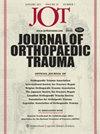肱骨近端骨折线性与曲线钢板远端三角肌破坏的量化:尸体研究
IF 1.6
3区 医学
Q3 ORTHOPEDICS
引用次数: 0
摘要
肱骨近端骨折的钢板固定通常与一定程度的远端三角肌剥离有关。本研究旨在量化肱骨近端骨折修复中使用标准线性钢板与曲线钢板时三角肌的松解情况。 七具非配对、新鲜冷冻的锁骨至指尖尸体肩部符合研究的纳入标准。对四种不同的肱骨近端植入物进行了测试。其中一个植入板为曲线型(89 毫米),另外三个为直线型(长度分别为 85 毫米、98 毫米和 109 毫米)。根据为正确定位钢板而释放的三角肌插入量对钢板进行比较。通过方差分析和事后 Tukey 检验,比较了每个制造商生产的三种最短平板的三角肌中断平均值。进行了线性回归分析,以分析钢板长度对三角肌平均松解度的影响。 三角肌插入长度的平均值为 39.6 ± 8.6 毫米(n=7)。曲线钢板(89 毫米)所需的三角肌平均释放量最少,为 4.1 ± 4.5 毫米,占三角肌插入长度的 12.1%。独立方差分析包括每个制造商生产的三种最短钢板,发现使用哪种钢板对三角肌破坏量有显著影响(F(2, 18) = 18.0, p < .001, ω = .6)。包括所有四块钢板在内的线性回归结果表明,钢板长度与三角肌平均释放量之间存在显著的直接统计学关系(y=.6x-43.8,r2=4)。 目前的研究表明,肱骨近端钢板长度与钢板接合过程中三角肌释放量有直接关系。虽然三角肌的破坏与长度有关,但钢板的形状(曲线形与直线形)也可能是造成三角肌破坏的原因之一。在比较长度相似的曲线形钢板和线形钢板时,曲线形钢板释放的三角肌平均量较少。本文章由计算机程序翻译,如有差异,请以英文原文为准。
Quantifying Distal Deltoid Disruption with Linear vs Curvilinear Plating of Proximal Humerus Fractures: A Cadaveric Study
Plate fixation of proximal humeral fractures is usually associated with some degree of distal deltoid dissection. The purpose of this study was to quantify deltoid release with standard linear vs. curvilinear plates utilized in the repair of proximal humeral fractures.
Seven nonpaired, fresh-frozen clavicle-to-fingertip cadaveric shoulders met the inclusion criteria for the study. Four different proximal humerus implants were tested. One of these plates was curvilinear (89mm), and the other three were linear (85mm, 98mm, 109mm in length). Plates were compared based on the amount of deltoid insertion released for proper plate positioning. An ANOVA with post hoc Tukey tests was conducted to compare mean deltoid disruption across the three shortest plate types from each manufacturer. A linear regression analysis was conducted to analyze the effect of plate length on mean deltoid release.
The mean deltoid insertion length was 39.6 ± 8.6mm (n=7). The curvilinear plate (89mm) required the least amount of average deltoid release at 4.1 ± 4.5mm, or 12.1% of the deltoid insertion. Independent ANOVA analysis including the three shortest plates from each manufacturer, found a significant effect of which plate was used on the amount of deltoid disruption that resulted (F(2, 18) = 18.0, p < .001, ω = .6). A linear regression including all four plates demonstrated a statistically significant direct relationship plate length and the mean deltoid released (y=.6x-43.8, r2=4).
The current study demonstrates that proximal humerus plate length has a direct relationship with the amount of deltoid released during plating. Although deltoid disruption is length dependent, plate shape (curvilinear vs linear) could also be contributory. When comparing a curvilinear and a linear plate of similar lengths, the curvilinear plate resulted in less mean deltoid release.
求助全文
通过发布文献求助,成功后即可免费获取论文全文。
去求助
来源期刊

Journal of Orthopaedic Trauma
医学-运动科学
CiteScore
3.90
自引率
8.70%
发文量
396
审稿时长
3-8 weeks
期刊介绍:
Journal of Orthopaedic Trauma is devoted exclusively to the diagnosis and management of hard and soft tissue trauma, including injuries to bone, muscle, ligament, and tendons, as well as spinal cord injuries. Under the guidance of a distinguished international board of editors, the journal provides the most current information on diagnostic techniques, new and improved surgical instruments and procedures, surgical implants and prosthetic devices, bioplastics and biometals; and physical therapy and rehabilitation.
 求助内容:
求助内容: 应助结果提醒方式:
应助结果提醒方式:


